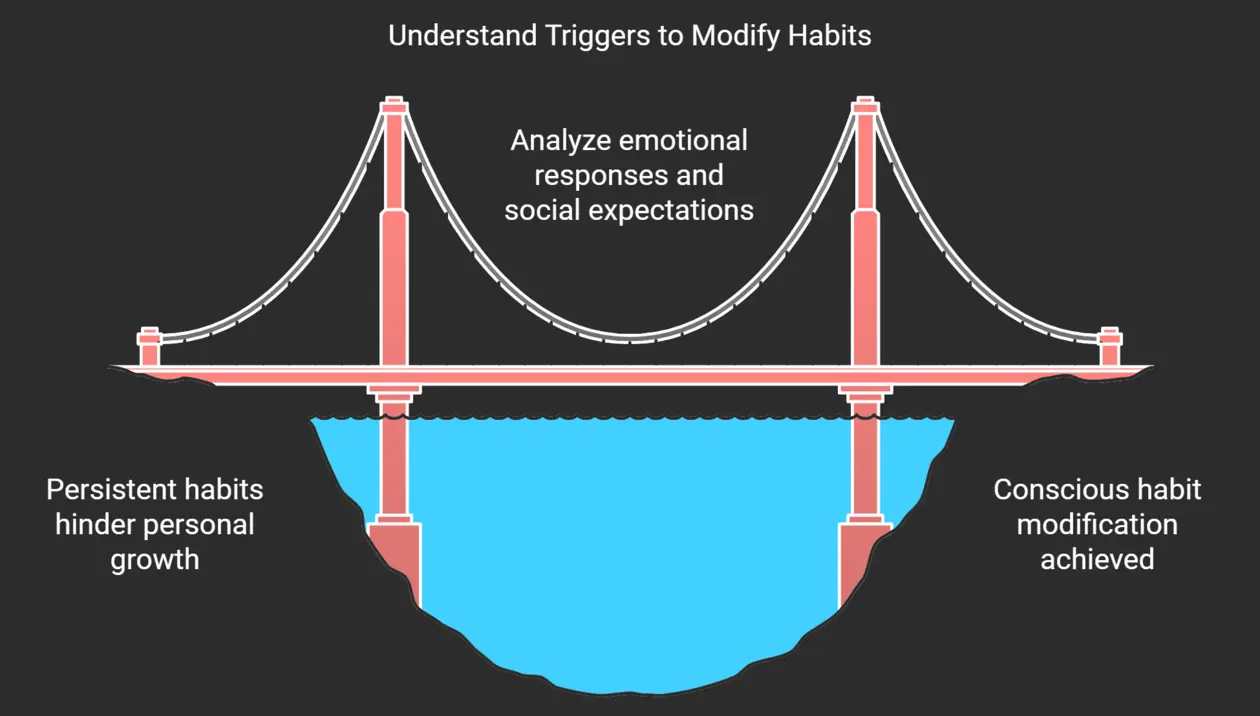Break Bad Habits In 2025 – Start Today

Breaking bad habits is challenging, especially due to the difficulty in changing habits that have become automatic routines. Understanding why they form, the triggers for bad habits, and what maintains them can make change possible.
Habits help our brain conserve energy by making repetitive actions automatic. This highlights their importance in our daily lives. Even bad habits become ingrained due to the biological basis of habits and dopamine release, which reinforces the behavior.
The good news is that conscious behavior modification can help break bad habits. In this article, we’ll explore practical strategies for breaking bad habits. I have learned these strategies along my journey and I will discuss how to create new, healthier routines.
What Causes Bad Habits?
Bad habits often arise from immediate rewards, even though they can bring long-term harm. Understanding the brain’s role in these patterns is key to overcoming them.
As Dr. Nora Volkow, Director of the National Institute on Drug Abuse, explains, “Understanding the biology of how we develop routines that may be harmful to us, and how to break those routines and embrace new ones, could help us change our lifestyles and adopt healthier behaviors.”
Our brains are wired to repeat behaviors, especially those that trigger pleasure, such as overeating, smoking, or drug use. Neurobiologist Dr. Russell Poldrack notes, “Enjoyable behaviors can prompt your brain to release a chemical called dopamine.
This strengthens the habit even more, creating a craving to repeat the behavior.” Despite these challenges, research shows that we are capable of change.
As psychologist Dr. Roy Baumeister emphasizes, “Self-control is like a muscle. Once you’ve exerted some self-control, it gets tired. But regular practice can strengthen your resolve.”
By understanding the science behind habits and applying strategies like mindful awareness and visualization, we can reshape our behaviors for better health.
Where do bad habits start:
Reflect and Analyze:
Take time to reflect on one of your persistent habits and consider these underlying factors. Is it tied to a specific emotional response, social expectation, or immediate reward? Understanding the complex interplay between triggers and behaviors provides a roadmap for conscious habit modification.
Identifying the deeper cause of your habit not only sheds light on its persistence but also suggests targeted strategies for change, like altering environmental cues, developing alternative coping mechanisms or practicing delayed gratification.

10 habit-breaking techniques
Here we cover behavioral change tips. These steps will help guide you in making meaningful changes to your behavior and creating healthier routines:
1. Understanding the Habit Loop
Habits often form through a three-part loop involving a cue, routine, and reward. The cue triggers the habit, the routine is the behavior, and the reward is the satisfaction gained afterward. This cycle reinforces the habit each time it’s repeated.
For instance, stress (cue) might trigger smoking (routine), with the perceived relaxation being the reward. Understanding this loop is the first step to breaking it and creating healthier patterns.
Suggested Action: Identify one habit you want to change. Write down its cue, routine, and reward. This will help you understand the habit loop and where to intervene.
2. Dopamine and Reward Systems
Engaging in habits, even negative ones, triggers a dopamine release. This makes it hard to resist cravings and addictive behaviors. This is why it’s hard to resist returning to old habits: dopamine creates a rewarding feeling.
The biological reward keeps pulling us back. Therefore, it is essential to find a healthier alternative that can provide a similar sense of satisfaction.
Suggested Action: List healthier activities that can provide a similar dopamine boost. Examples include exercising, listening to music, or spending time with friends.
3. Identify Your Triggers
To change a bad habit, you first need to understand what triggers it. Triggers can be internal, like stress, or external, like seeing someone else perform the habit. Keeping a journal can help reveal your cues. Track when and why you engage in a habit.
This is crucial in habit formation psychology. It also helps in identifying habit cues. For example, if you snack late at night, note the emotions or events leading up to it. These could be boredom or a TV show. Look for patterns.
Suggested Action: Start a habit journal for one week to identify the triggers that lead to your habit.

4. Swap Out Bad Habits for Good.
It’s easier to replace a habit than to simply try and remove it. When you recognize a cue, substitute a healthier behavior. If stress drives you to smoke, replace it with deep breathing or going for a walk. Replacing the routine is crucial. Keep the same trigger and reward.
This strategy makes it more likely the change will stick.
Suggested Action: Choose a healthier alternative to replace your bad habit. Plan how you’ll implement it the next time you’re triggered.
5. Manage Urges Effectively
Urges follow a predictable cycle, often peaking within 20 minutes and then fading. To manage urges, try distracting yourself during this window. Set a timer for 20 minutes. Engage in an activity like reading or exercising.
This can help you ride out the craving. The key is knowing that urges are temporary. They will pass. Engage in a hobby you enjoy during this time.
Suggested Action: When an urge hits, set a timer for 20 minutes and distract yourself with an engaging activity.
“Understanding the biology of how we develop routines that may be harmful to us is important. Learning how to break those routines and embrace new ones could help us change our lifestyles. It can lead us to adopt healthier behaviors.” — Dr. Nora Volkow, NIH’s National Institute on Drug Abuse.
6. Acceptance of Setbacks
No change is linear. You’re likely to experience setbacks, and that’s okay. Setbacks in habit change are common because habits are deeply ingrained. Breaking them requires consistent effort and self-control that requires practice. Reframe setbacks as learning opportunities.
They provide valuable insights into your triggers and areas where you need more support. Viewing setbacks positively can help you stay motivated and keep moving forward. It’s important to be compassionate with yourself and view setbacks as part of the process rather than a failure.
Acknowledging that progress takes time and that mistakes are normal can help you maintain motivation.
Suggested Action: Write down a positive affirmation to remind yourself that setbacks are normal and part of growth.
7. Practice Self-Compassion and Use a Third-Person Perspective
A helpful strategy is to take a third-person perspective when reflecting on your habits. Instead of being overly critical, think about what advice you would give a friend in your situation.
This approach can help you be kinder to yourself, reduce self-blame, and improve resilience. Treating yourself kindly can make a significant difference in staying on track toward positive change.
Suggested Action: Next time you’re feeling frustrated, write down what advice you would give a friend in the same situation.
8. Small, Gradual Changes Are More Effective
Avoid the all-or-nothing mindset. Do not try to quit a habit cold turkey. Make small changes. Start by reducing consumption by a small amount each day. If you want to reduce screen time, start by cutting down to 10 minutes each day.
Gradual behavior change prevents burnout. It makes new habits more sustainable over time, supporting lasting change.
Suggested Action: Set a small, achievable goal related to your habit change and track your progress daily.
Subscribe to Create Higher Vibrations!
Get Inspiration and Practical advice straight to your inbox.
9. Reinforce New Routines Until They Become Automatic
The goal isn’t just to eliminate old habits but to reinforce new routines until they become automatic behavior patterns. Establishing a routine is key. Consistency helps cement a new behavior. Your brain adopts it as the new default. This reduces the effort needed to maintain it over time.
Suggested Action: Create a daily schedule that incorporates your new habit to help reinforce consistency.
10. Get Support from Family and Friends
Changing habits is easier when you have support. Sharing your goals with family or friends can provide accountability and encouragement.
Engaging in activities together, such as a fitness goal, can help replace negative behaviors with positive, social experiences. Support systems for habit change are crucial in building healthier habits.
Suggested Action: Share your habit change goal with a friend or family member. Ask for their support to help keep you accountable.
FAQs On How To Break Bad Habits
Research suggests it can take anywhere from 18 to 254 days to break a habit, depending on the individual and the complexity of the habit. Consistency is key to making new behaviors stick.
Triggers can be internal, like stress or boredom, or external, like being in a particular setting or seeing others engage in the behavior. Identifying and understanding your triggers is an important part of breaking the habit.
Bad habits are reinforced by dopamine, which makes them feel rewarded. Additionally, they are often ingrained in routines that our brains rely on for efficiency. To break a habit, you need to disrupt the cue-routine-reward loop and replace it with a positive behavior.
Slipping up is normal and part of the process. Self-compassion is important—treat yourself kindly, learn from the experience, and get back on track.
Final Thoughts
Breaking bad habits is a journey that requires patience, persistence, and a willingness to look inward. The difficulty in changing habits means that persistence in behavior change is essential. Understand the causes of your bad habits.
Recognize psychological triggers for habits. Replace negative routines with positive behaviors. These are key steps to lasting change.
Remember, progress takes time, and setbacks are part of the process. Use this opportunity for self-inquiry. Reflect on the habits you’d like to change. Understand why they exist. Take small but consistent actions to create a healthier future.
Take some time today to journal about one habit you’d like to break. Ask yourself why it started. Consider the benefit you perceive it provides. Think about how you can begin to replace it with a healthier behavior.
Share this article on Social media with your thoughts if you believe it can help someone you know!


